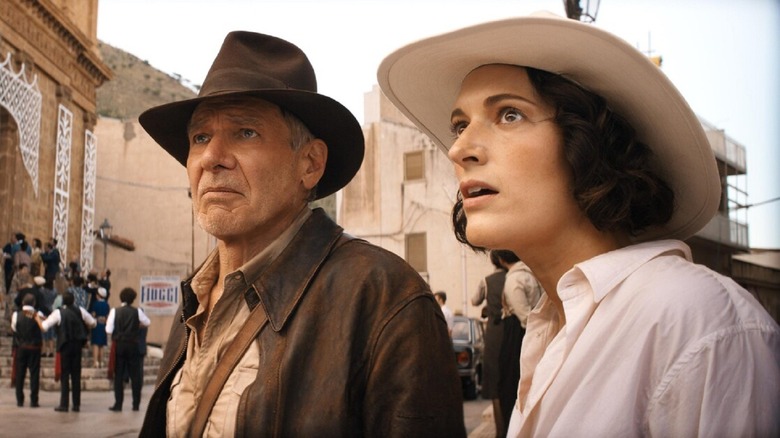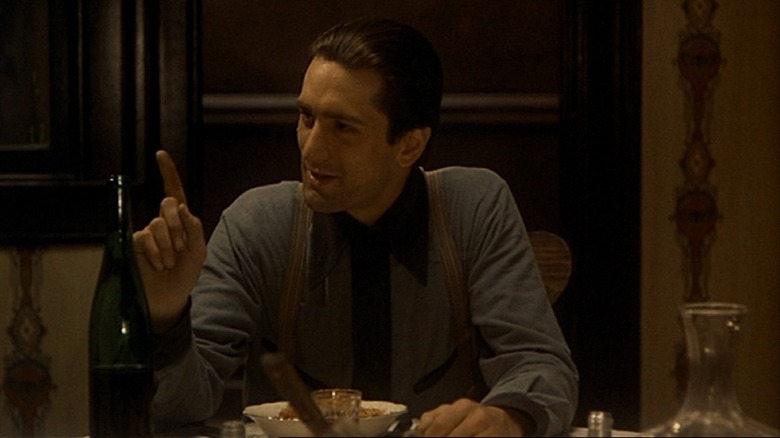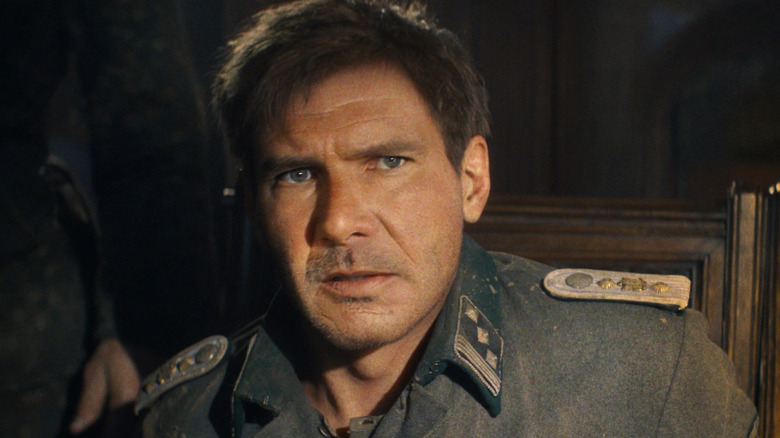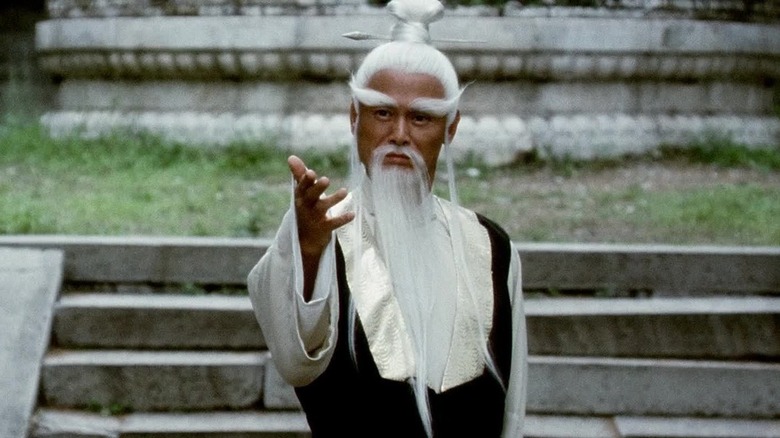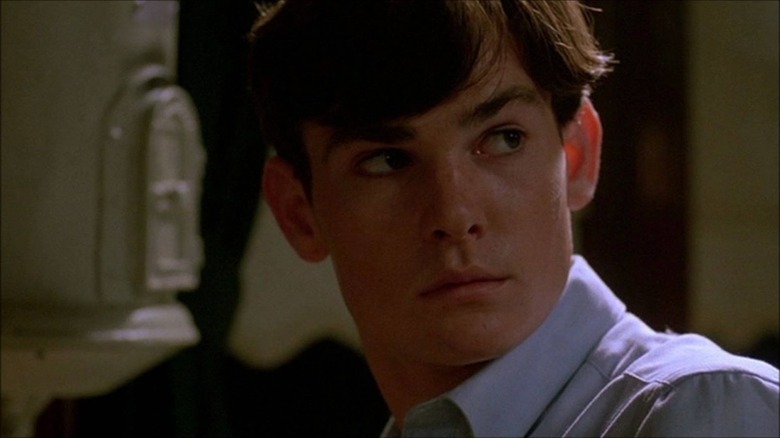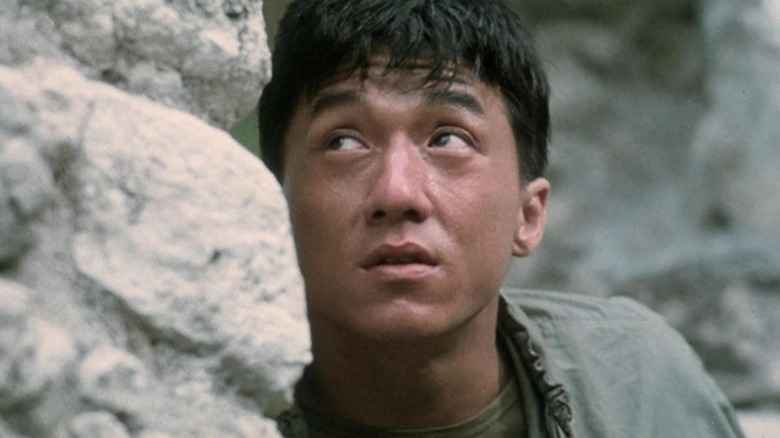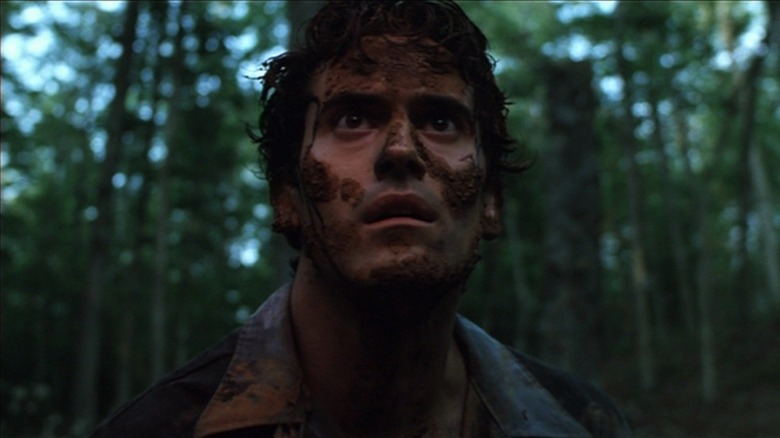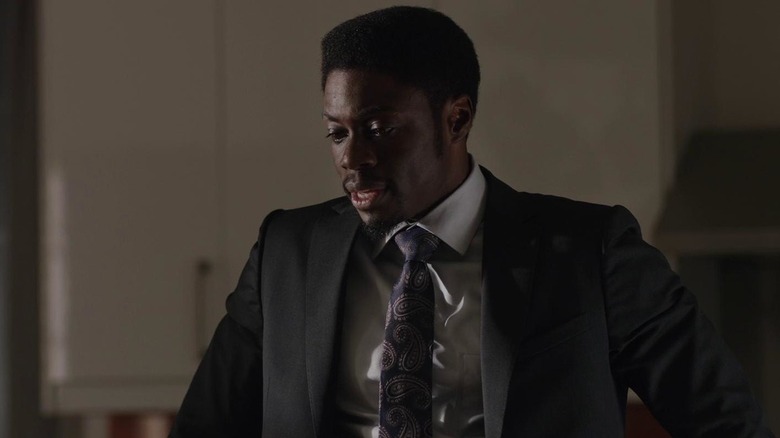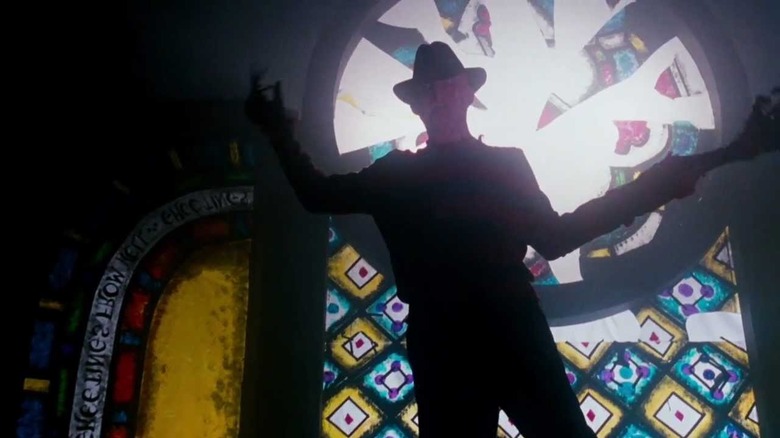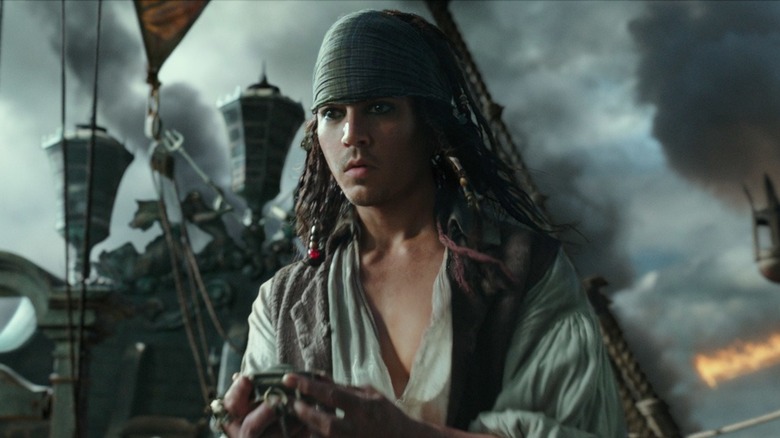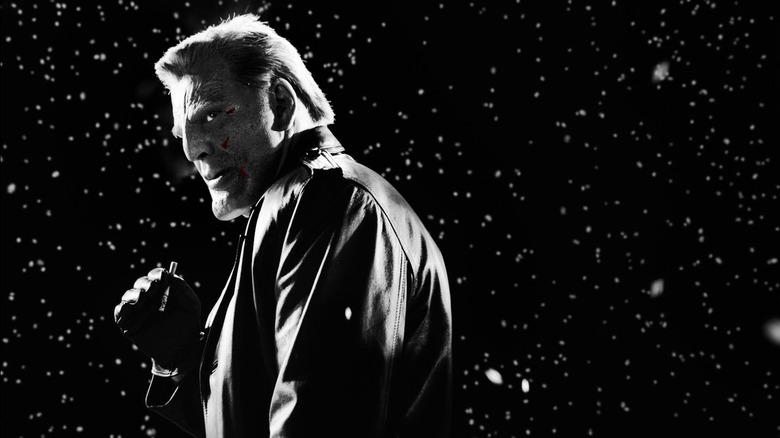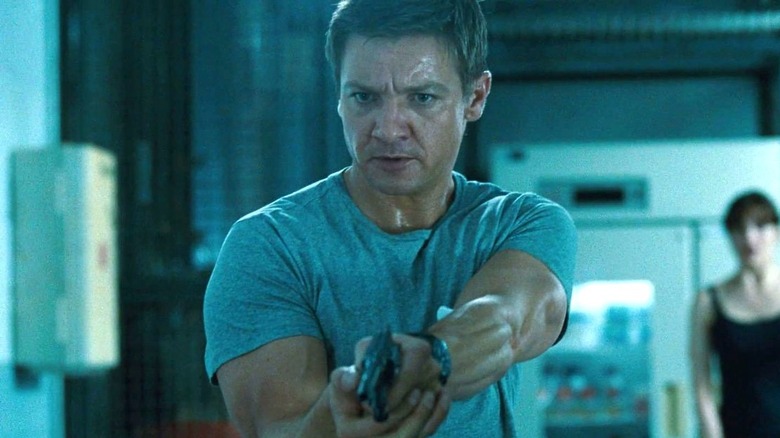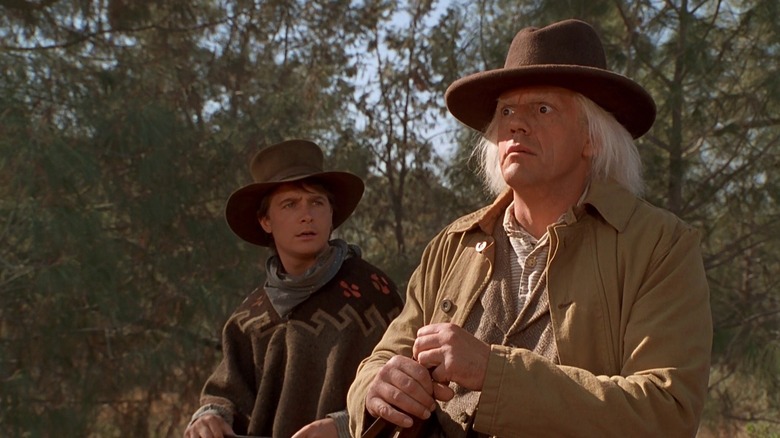Movies That Are Prequels And Sequels Simultaneously
If a film is successful and the folks in charge decide to extend the story, they have a few options to decide between. The most common route is to keep the ball rolling with a direct sequel, but delivering an origin story or going back in time for other reasons in a prequel is also quite common. Far less often, the creative team decides to have things both ways and craft a narrative that is both a prequel and sequel to the preceding film at the same time.
Pulling off this tricky balance requires extensive flashbacks, non-chronological storytelling, dual storylines, or a novel blend of all of the above. When used effectively, the combo prequel-and-sequel approach can deepen your understanding and appreciation of the original film while also delivering the next chapter in an ongoing saga. But, when handled poorly, the result can feel like a jumbled, unfocused, and overstuffed mess. The following rundown contains examples of both successful and unsuccessful attempts to blend prequel and sequel storylines.
The Godfather Part II
Arguably the single greatest example of a prequel-sequel hybrid can be found in "The Godfather Part II." A six-time Oscar winner and one of the most highly-acclaimed films ever made, "The Godfather Part II" is proof — if ever it were needed — that a prequel and sequel do not need to be kept separate.
In this film, the surviving characters from "The Godfather" continue their ongoing storylines in one half of the narrative, while the other half takes place decades earlier. As Michael Corleone (Al Pacino) grows increasingly more ruthless and an irrevocable rift forms in the family, his story is intercut with the rise to power of his father Vito Corleone, played by Marlon Brando in the original film and here by Robert De Niro. Both plotlines are equally compelling and speak to each other on a thematic level as they showcase the formation and growth of the Corleone crime family and the similarities and differences between father and son.
Interestingly, the prequel component of "The Godfather Part II" is adapted straight from Mario Puzo's original "The Godfather" novel, while the sequel part that follows the further developments of Michael and the other surviving Corleones was entirely original material that extended beyond the book. Puzo and others eventually wrote additional novels in the book series, but "The Godfather Part II" film preceded the second book in the series by an entire decade.
Indiana Jones and the Dial of Destiny
One of the more recent films to combine both prequel and sequel elements is "Indiana Jones and the Dial of Destiny." The extended prequel section arrives right at the start of the film with the titular character going on an adventure in his mid-40s before it jumps forward to the year 1969 where the character is now 70 years old. The prequel portion of Indy's adventure was pulled off by digitally de-aging Harrison Ford — now in his 80s — using a combination of CGI, artificial intelligence, and other cutting-edge techniques developed by Industrial Light and Magic, the effects company founded by George Lucas back in the '70s. After the opening act, "Dial of Destiny" shifts gears from a prequel into a sequel for the remainder of the film.
This is not the first time that the Indiana Jones series has played around with its timeline. "Indiana Jones and the Temple of Doom" was a subtle prequel taking place before the events of the first movie – not that it mattered too much in the grand scheme of things. The third movie, "Indiana Jones and the Last Crusade," navigated a similar balance to "Dial of Destiny" and featured a prologue set in Indy's younger days, offering a glimpse at how he got into adventuring. Back then, the teenage Indiana Jones was played by River Phoenix for the introductory sequence before jumping forward to Ford's adult Indy for the remainder of the film.
Kill Bill: Vol. 2
"Kill Bill: Vol. 2" continues the Bride aka Beatrix Kiddo's (Uma Thurman) quest for revenge while also delving into considerably more backstory than the first film. "Kill Bill: Vol. 1" begins with the Bride being shot in the head by Bill (David Carradine) on her wedding day before jumping years into the future when she wakes up from a coma and sets out to kill Bill and the other four members of his Deadly Viper Assassination Squad. "Vol. 2" spends more time on the day of the wedding in the tense moments leading up to the massacre. Audiences are introduced to the man Kiddo was marrying and allowed a look at her tense interactions with Bill before the violence starts. A different flashback offers a brief glimpse at what things were like between Bill and Kiddo when they were on good terms.
"Vol. 2" is also home to the extended Pai Mei (Chia-Hui Liu) sequence. This chapter of the Bride's life depicts the grueling training and physical conditioning that she was put through in order to become the elite assassin that she is at the start of "Vol. 1." A special cut combines both volumes into a single film as "Kill Bill: The Whole Bloody Affair," which has never been released on physical media and can only be caught at special screenings. "The Whole Bloody Affair" re-orders a few key moments but mostly keeps the structure of the two films the same and separates them with an intermission, though, obviously, there is no distinct sequel or prequel component when both volumes are combined as an individual outing.
Psycho IV: The Beginning
Released in 1990 as a TV movie, 30 years after Alfred Hitchcock's original classic, "Psycho IV: The Beginning" is far from being an essential entry in the series. While almost certainly being the weakest of the Anthony Perkins-led "Psycho" movies, the fourth outing does offer the biggest look into the history of Norman Bates as a deranged killer. Whether or not an origin story was necessary for this character is another question altogether — though the "Bates Motel" television series eventually undertook the same goal 13 years later.
The plot of "Psycho IV" is divided cleanly into two halves that alternate back and forth over the span of a few decades. The first half of the narrative is spent following modern-day Norman Bates as he calls into a radio program, worries about the psychological state of the baby that he has on the way, and continues to struggle with the split personality of his mother taking over. The other half is spent in Norman's youth, where he is played by Henry Thomas in one of his first roles after "E.T. the Extra-Terrestrial." The prequel portion of the film takes place before the death of his mother (Olivia Hussey) and gives a taste of the torment she inflicted on Norman. Audiences are shown Norman's fast descent into madness, his first kills, and his first time being taken over by the personality of his mother.
Operation Condor
"Operation Condor" is a strange case of a film being considered either a prequel or sequel depending on where in the world you watch it. In the strictest sense, the series began with "Armour of God" released in 1986. Jackie Chan stars as Asian Hawk, a treasure-hunting adventurer and essentially Chan's spin on the Indiana Jones archetype. "Armour of God" didn't have full international distribution and wasn't released in the U.S. and various other countries right away. However, things got confusing five years later when the sequel was released.
"Armour of God II: Operation Condor" hit theaters in 1991 and had a far larger international reach, premiering in Hong Kong and the U.S. simultaneously. The only problem was, the U.S. still hadn't gotten the first "Armour of God" yet, so they had no idea what the movie was a sequel to. For the U.S. and certain other territories, the title was changed to just "Operation Condor," removing any indication that the movie was a sequel. To make matters significantly more confusing, 1986's "Armour of God" was eventually released in the U.S. — at which point its title was changed to "Operation Condor 2" — making each movie both a sequel and prequel to the other conditionally.
Chan plays the same character in each film, but they are largely self-contained adventures, so the swapped order doesn't alter much, though "Armour of God" does look significantly older than "Operation Condor." Chan eventually turned the series into a trilogy in 2012 when he reprised the Asian Hawk character for "Chinese Zodiac," which was mostly marketed as a standalone film rather than a sequel.
Evil Dead II
Sam Raimi's 1981 horror film "The Evil Dead" was a massive success story, taking a tiny budget, finding lasting success, and launching multiple successful careers. When Raimi and star Bruce Campbell returned for the sequel in 1987, they took an unorthodox approach. "Evil Dead II," which is also known as "Evil Dead 2: Dead by Dawn" opens up with an introductory act that essentially remakes the events of the first film on a compressed timeline. The remake prologue changes up a few details from the original in order to better establish the events that follow in the out-and-out sequel portion that makes up the rest of the film.
By reworking the timeline of the original movie and skewing the events, the opening act of "Evil Dead II" essentially becomes its own prequel mulligan while still delivering an effective sequel to the original movie. The ultimate balance works out to be somewhere around 10% remake or prequel and 90% sequel. Raimi would continue the story five years later with "Army of Darkness," which finds the protagonist getting sent back in time to the medieval age.
Jigsaw
Few movie series have a chronology as twisted and confusing as the "Saw" series. After the relatively contained and straightforward original movie, each outing has leaped through increasingly far-fetched hoops to deliver plot twists and surprising reveals. Many of the twists involve revealing that events secretly took place at different points on the overall franchise timeline than viewers were first led to believe, such as extensive flashbacks to events taking place before even the first movie, or events being shown out of order in a deliberately confusing manner. For example, the plot twist in "Saw II" reveals that half of the film actually took place before the other half despite them being presented as if they were occurring simultaneously.
The eighth film in the series, 2017's "Jigsaw," takes on a narrative structure that is divided between prequel and sequel. Half of the film takes place at the earliest point on the series timeline, while the other half was the latest point in time chronologically until "Spiral" came along in 2021. The confusing timeline became something of a hallmark for the "Saw" series, which made the mistake of killing off its most iconic character in the third movie, requiring constant flashbacks throughout the rest of the sequels to keep him involved.
A Nightmare on Elm Street 5: The Dream Child
Freddy Krueger's background and origin story in the "A Nightmare on Elm Street" series was slowly unveiled over the course of several movies, though the details don't remain 100% consistent from film to film. The fifth film in the series, "The Dream Child," became a prequel in part by revealing more details about the conception of Krueger and depicting the terrible events that happened to his mother, Amanda Krueger. The event had been described earlier in the series, but "The Dream Child" was the only film to go back in time and show it happening.
While working as a nun at an insane asylum, Amanda was accidentally locked in with the dangerous inmates, which led to Freddy's conception and him being labeled as the bastard son of 100 maniacs. By utilizing the dream logic that was the trademark of the series, "The Dream Child" is able to show this prequel origin story through the eyes of Alice (Lisa Wilcox), who also has her own storyline set in the present day. The vast majority of "The Dream Child" follows the events of the previous movies, but the prequel sequence is arguably the most memorable part of this otherwise lackluster sequel.
Pirates of the Caribbean: Dead Men Tell No Tales
"Pirates of the Caribbean: Dead Men Tell No Tales" is the fifth movie in the long-running "Pirates of the Caribbean" franchise, and is part sequel, part origin story for Captain Jack Sparrow. While the sequel portion of the film finds Sparrow played by Johnny Depp as usual, more creative measures were needed to pull off the prequel portion of the movie.
When back in Sparrow's teenage years, the character was performed by both Depp and a younger actor, Anthony De La Torre, who bears a resemblance to Depp. Johnny Depp would act out each scene involving the young Jack Sparrow, then De La Torre would attempt to mimic him as closely as possible, then the two would be merged into a single character through extremely complex VFX. The de-aging was handled by Lola, the same effects company that had previously worked on the de-aging of Brad Pitt for "The Curious Case of Benjamin Button." The technology, unsurprisingly, improved over the years, though the end result still has a foot in the uncanny valley. All of the high-tech work done by the effects team wasn't reflected in the film's overall quality as "Dead Men Tell No Tales" was trashed by many critics and became the lowest-rated entry in the series on Rotten Tomatoes.
Sin City: A Dame to Kill For
2014's "Sin City: A Dame to Kill For" was the long-belated follow-up to the original "Sin City" film from 2005. Just like the first movie, "A Dame to Kill For" is a vignette film telling multiple stylized storylines that follow different characters. Some of the vignettes take place after the events of the original movie, while others serve as prequel stories.
Multiple characters who died in "Sin City" return for "A Dame to Kill For," such as Marv (Mickey Rourke), whose prequel storyline takes place before his encounter with Goldie that ultimately leads to his death. John Hartigan (Bruce Willis) also died in the first movie but returns briefly as a sort of ghost or delusion in the continuing storyline of Nancy (Jessica Alba), who underwent a significant transformation from the first movie to the second. The Dwight vignette is also a prequel to the original film, with the role changing hands from Clive Owen to Josh Brolin and the character undergoing facial reconstruction surgery to explain the major change in appearance. There are still plenty of other volumes of the Sin City graphic novel series set both before and after the plotlines that have been adapted thus far. If a third "Sin City" film ever comes to fruition, prequel and sequel source material is ready and waiting.
The Bourne Legacy
As the only "Bourne" movie not starring Matt Damon, "The Bourne Legacy" is the undisputed outcast of the series. The continuity between "The Bourne Identity" and "The Bourne Supremacy" was simple enough, but the timeline grew increasingly complicated from "The Bourne Ultimatum" onward.
The series' first major chronological shake-up started with the closing scene of "Supremacy," in which Bourne tells Pamela Landy (Joan Allen) that she looks tired over the phone, revealing that he has located her and is much closer than she thought. This same exact scene shows up again partway through "Ultimatum," twisting up the series chronology. With this phone call scene as an anchor point, it becomes clear that parts of "Ultimatum" take place before, during, and after the events of "Supremacy," making it a hybrid sequel, prequel, and sidequel all at once. "The Bourne Legacy" took a similarly complicated approach by setting the action before, during, and after the events of "Ultimatum" while following a new super spy character: Aaron Cross (Jeremy Renner). Given Bourne's absence from the film, the chronological overlap happening in "Legacy" is less meaningful and more likely to be overlooked or shrugged off altogether. After the poor reception of "Legacy," the "Bourne" series went dark for a few years until returning with a more straightforward timeline and with Damon back in the lead role in 2016's "Jason Bourne."
Back to the Future Part III
Things are bound to get complicated whenever a movie series incorporates time travel. As perhaps the quintessential time-travel adventure series, "Back to the Future" keeps things commendably easy to follow while still indulging in plenty of fun time-related hijinks. "Back to the Future Part II" already featured some overlap with the first movie, becoming both a sequel and a sidequel in part.
"Back to the Future Part III" took things a step further by going the farthest back in time by many, many decades. The bulk of the action this time around takes place in the wild west, preceding every other event in the series by a significant margin. While the wild west plotline doesn't directly impact what eventually happens in the other films in too many ways, there are a few instances of cause and effect that turn their adventure into a prequel and shape the future that audiences already saw. Viewers are even treated to yet another generation of the Tannen clan in the form of Buford "Mad Dog" Tannen (Thomas F. Wilson), who lives up to his moniker and fits right in among his descendants.
